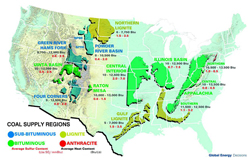
Hydrogen and Clean Fuels
Hydrogen and Clean Fuels Basics
Hydrogen Strategies
Central Hydrogen Production
|
|
| |
 |
| |
CLICK ON IMAGE TO SEE LARGER VIEW |
|
|
Coal is a plentiful domestic resource, and is available in several major regions of the U.S., as illustrated in the figure at right. The U.S. has lots of coal, at least 250 years supply at current use rates. Production will increase by ~50% by 2030 primarily for electric power increases. Even if production was doubled and the rest of the increase used to produce hydrogen or liquid fuels, there would still be over 100 years of supply. Prices of coal have been relatively stable compared to those of petroleum or natural gas and the costs to make hydrogen or liquid fuels from coal, while sequestering potential greenhouse gas emissions from the production process, are close to a range that would be competitive with current and projected gasoline prices. One way to a hydrogen-based transportation system would be to make hydrogen at large central plants, perhaps in coal-producing regions, and develop a distribution system to get it to vehicle filling stations, where fuel cell vehicles could be refueled, as shown in the “Central Hydrogen Production” figure below.

This scenario will be possible only when fuel cell vehicles can be produced at competitive prices, and when solutions are found to hydrogen transport and storage issues.
Alternate Production
In the Alternate Production technology pathway, shown in the “Alternate Production” figure below, clean syngas from coal is converted to high-hydrogen-content liquid hydrocarbon carriers, alcohols, or methane (“substitute natural gas or SNG”).

These products have the benefit of being deliverable through our existing fuel distribution infrastructure, and can be “reformed” to provide hydrogen near the point of use, thus providing a potential acceleration of hydrogen market penetration until hydrogen pipeline systems are installed. The evaluation and identification of these alternate pathways are an important part of this RD&D program. Natural gas could be used as a hydrogen source for distributed production, at least on a short-term basis, and replaced by SNG as production facilities are developed. This research can also apply to reducing costs of renewable sources of hydrogen such as biomass.
With high gasoline prices, there is growing national interest in coal-to-liquids (CTL) technologies. If industry has confidence that oil prices will stay above ~ $45 per barrel of oil, the economics of CTL would be encouraging. If sequestration of carbon is required, NETL estimates that the cost per bbl would be increased by about $4/bbl. Another promising option recently analyzed by NETL is to combine coal with biomass in a gasifier to produce liquid fuels (called Coal/Biomass to Liquids [CBTL]) or hydrogen. The Hydrogen and Clean Fuels program is evaluating the technical basis for CBTL. Recent legislation authorizes the Department of Defense (DoD) to look into using CTL as an alternate resource and asks DOE to study possible incentives. The government could facilitate development of CTL and help focus existing activities in areas such as IGCC projects, as well as collaborate in fuels testing with DOD. If the research sponsored by the Hydrogen and Clean Fuels program is successful, hydrogen or other clean fuels can be made from coal at low cost and contribute to reducing CO2 emissions. This work could position the Nation’s primary energy industries so they can produce up to 10 percent of our transportation fuel needs (1.6-2.0 million barrels per day) by 2025.
 |
|
|
|